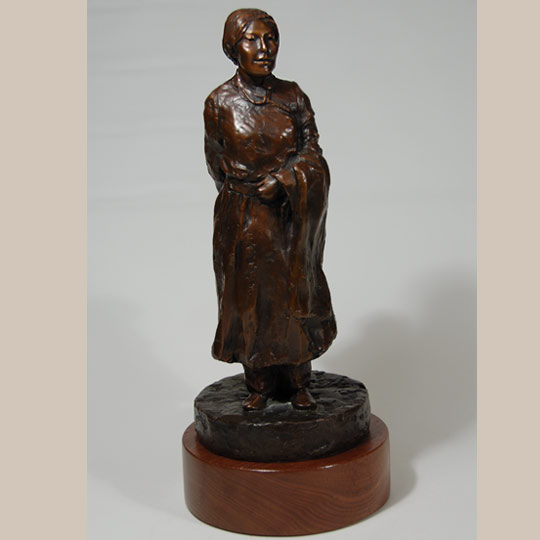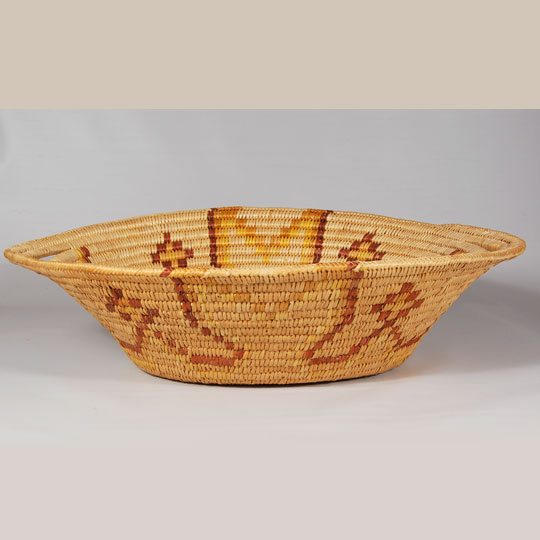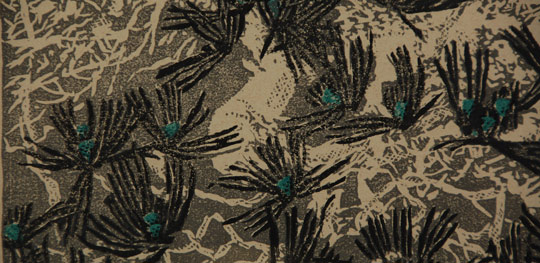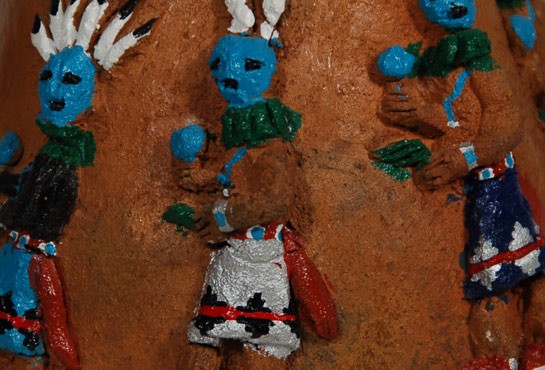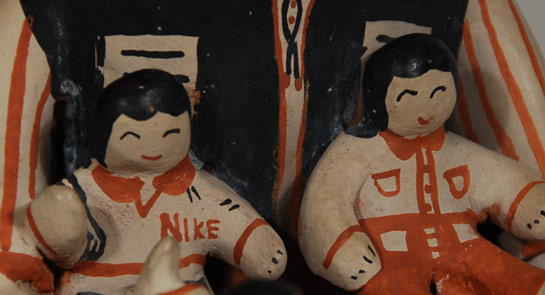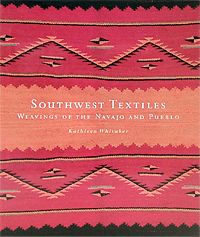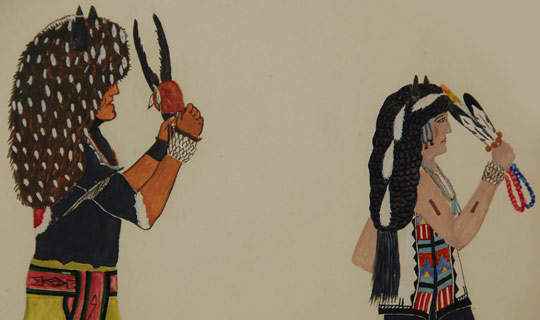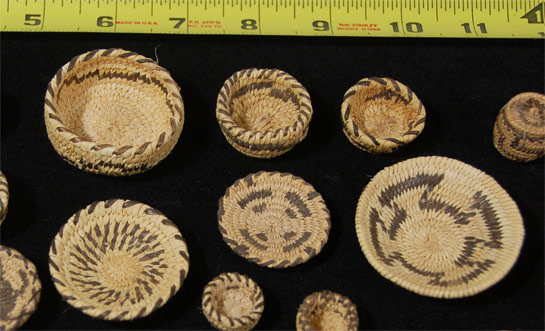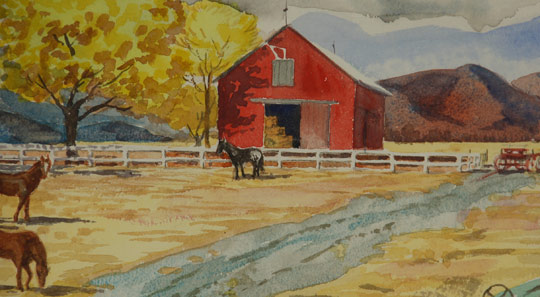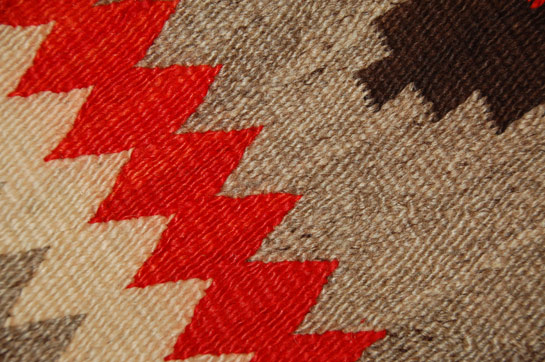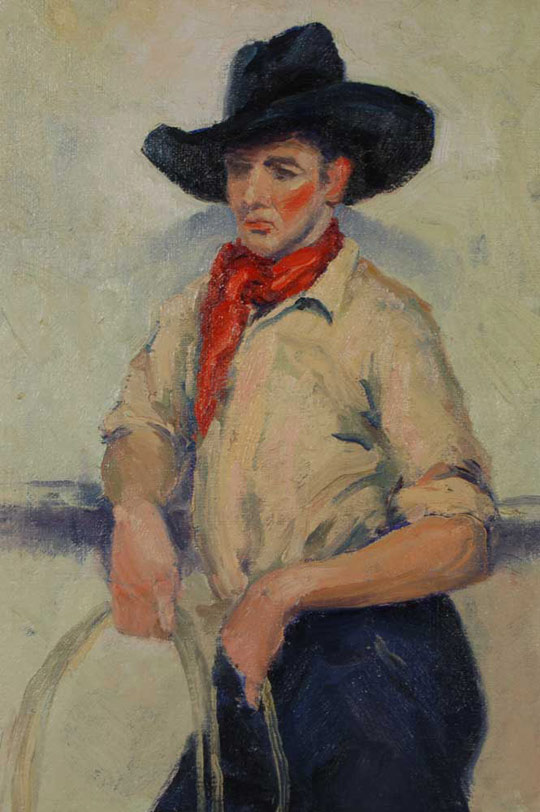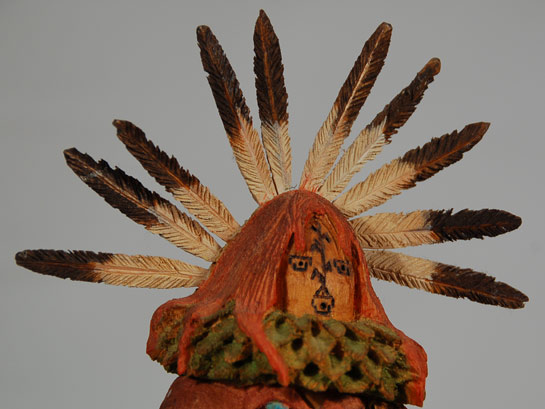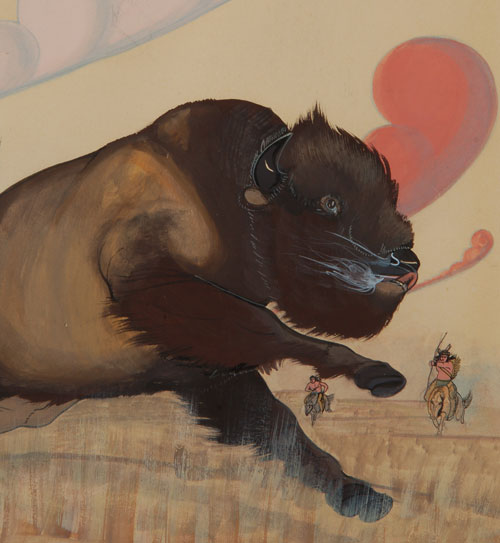Biography: Harrison Begay (1914-2012)
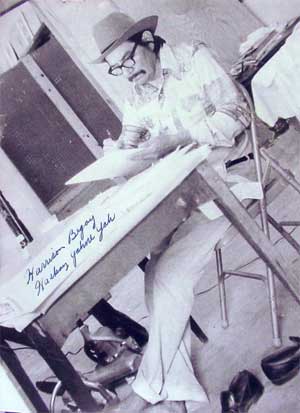 Harrison Begay, or Haskay Yahne Yah (The Wandering Boy*), to his knowledge, was born in 1914 approximately fourteen miles west of present-day Greasewood, Arizona, on the Dine` (Navajo) Reservation at a place known as Whitecone. His date of birth is often cited as a few years later, however, there are no records and Harrison prefers the year 1914.
Harrison Begay, or Haskay Yahne Yah (The Wandering Boy*), to his knowledge, was born in 1914 approximately fourteen miles west of present-day Greasewood, Arizona, on the Dine` (Navajo) Reservation at a place known as Whitecone. His date of birth is often cited as a few years later, however, there are no records and Harrison prefers the year 1914.
When he was a boy of seven years, his mother died and soon after that he was sent off to government boarding schools. As he grew older he decided to study art in Santa Fe where an art school was organized by the government in the early 1930s. From 1934 until about 1940 he attended this school under Dorothy Dunn. Following art school, Harrison attended college and then enlisted in the U.S. Army during World War II. Serving under General Dwight Eisenhower, Harrison did not have much opportunity to pursue his painting. Soon after his discharge and return to Arizona he was able to begin once more his study of art. Then in the 1960s he again met General Eisenhower at the annual Ceremonials in Gallup, New Mexico. At that time Harrison presented General Eisenhower with one of his fine paintings which is in a permanent collection in Washington, D.C. "Begay's paintings have exerted greater influence on Navajo artists than any other person. His work is internationally known."
-Snodgrass 1968.
* Note: Most published references to Harrison Begay state that the translation of his name Haskay Yahne Yah is "Warrior Who Walked Up to His Enemy." The correct translation is "The Wandering Boy." Thanks to Jim C. Hunt for bringing this to our attention. Hunt's father spent the better part of his life on the Navajo reservation. He taught the Navajo language at Northland Pioneer College in Holbrook, AZ, and was beyond fluent in the language. It was he who told the younger Hunt the correct translation. Our thanks to the Hunts for this enlightenment.
Harrison Begay Obituary
We were sorry to hear today that Navajo artist Harrison Begay passed away on Tuesday of this week (August 21, 2012) at the age of 95 years. He is survived by his siblings Alice Clah, Anita Begay, Mary Joy Begay, Cecil Blackrock and Sarah Brown. His burial will take place at the Ft. Defiance Veterans Cemetery, Arizona.
Begay was one of the early 20th century Navajo artists and the last of a long line of Southwest Native American artists. We know of only two others of his generation who are still with us and they are Geronima Montoya (Potsunu) of Ohkay Owingeh Pueblo, who is now 97 years old and Navajo artist Beatien Yazz who is now 84 years of age. It is sad to see them go but they have all left us some remarkable art by which to remember them.
Biography: Glenna Goodacre (1939- )
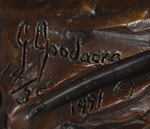 Glenna Goodacre is a well-known, perhaps the best known, female sculpture artist. Her sculptural works appear in public, private, municipal and museum collections throughout the United States. Probably her most well-known sculpture is the Vietnam Women's Memorial installed in Washington, D.C. in 1993. She was selected to create the monumental Irish Memorial in Philadelphia which was installed in 2003, a larger than life-size sculpture of Ronald Reagan for the Reagan Library in Simi Valley, California, the design of the Sacagawea dollar coin for the U. S. government, and many more monumental works.
Glenna Goodacre is a well-known, perhaps the best known, female sculpture artist. Her sculptural works appear in public, private, municipal and museum collections throughout the United States. Probably her most well-known sculpture is the Vietnam Women's Memorial installed in Washington, D.C. in 1993. She was selected to create the monumental Irish Memorial in Philadelphia which was installed in 2003, a larger than life-size sculpture of Ronald Reagan for the Reagan Library in Simi Valley, California, the design of the Sacagawea dollar coin for the U. S. government, and many more monumental works.
Goodacre was born in Lubbock, Texas, but lives in Santa Fe. She had been represented by Nedra Matteucci Galleries in Santa Fe for over a decade with annual exhibits of her works until her serious brain trauma following a fall at her home in 2007, which put a temporary end to her art career. Goodacre made many monumental bronze sculptures, larger than life, but also made table top or pedestal sculptures such as this one of a woman and child dancing.
Title: Bronze Sculpture “Dance Day”
 Glenna Goodacre is a well-known, perhaps the best known, female sculpture artist. Her sculptural works appear in public, private, municipal and museum collections throughout the United States. Probably her most well-known sculpture is the Vietnam Women's Memorial installed in Washington, D.C. in 1993. She was selected to create the monumental Irish Memorial in Philadelphia which was installed in 2003, a larger than life-size sculpture of Ronald Reagan for the Reagan Library in Simi Valley, California, the design of the Sacagawea dollar coin for the U. S. government, and many more monumental works.
Glenna Goodacre is a well-known, perhaps the best known, female sculpture artist. Her sculptural works appear in public, private, municipal and museum collections throughout the United States. Probably her most well-known sculpture is the Vietnam Women's Memorial installed in Washington, D.C. in 1993. She was selected to create the monumental Irish Memorial in Philadelphia which was installed in 2003, a larger than life-size sculpture of Ronald Reagan for the Reagan Library in Simi Valley, California, the design of the Sacagawea dollar coin for the U. S. government, and many more monumental works.
Goodacre was born in Lubbock, Texas, but lives in Santa Fe. She had been represented by Nedra Matteucci Galleries in Santa Fe for over a decade with annual exhibits of her works until her serious brain trauma following a fall at her home in 2007, which put a temporary end to her art career. Goodacre made many monumental bronze sculptures, larger than life, but also made table top or pedestal sculptures such as this one of a woman and child dancing.
This sculpture was issued in 1991 in an edition of 35, of which this is number 14. It is signed by the artist.
Condition: original condition
Provenance: from the estate of a Colorado collector of fine art
Title: Bronze Sculpture "Dance Day"
Artist: Glenna Goodacre (1939-present)
Category: Bronze
Origin: European-American Artists
Medium: bronze sculpture, wood base
Size: 11-7/8" and 13-3/4" with wood pedestal
Item # C3356C
Subject: Oval Shaped Serving Basket with Handles
Jicarilla Apache basketry covers a long span of time, but very little is known of their work before they were settled on a reservation in 1887 in northern New Mexico. All Jicarilla baskets are of coil weave, usually of sumac, but sometimes of willow. The Jicarilla Apache women generally made large deep basket bowls for winnowing or storage. They were designed with elements of commercial dyes, so fading is quite normal on a basket of some age.
The Jicarilla Apache Nation is located in the mountains and rugged mesas of northern New Mexico. The landscape offers diverse scenery of Ponderosa pine forests in mountainous terrain and piñon (pine tree) mesas with sage brush flats. Dulce, New Mexico, is the Jicarilla Apache Nation Headquarters.
This basket is typical of the style made for sale to collectors and visitors to the Jicarilla village. It is oval shape and the outer two rows at the top of the basket were extended to form handles at the two ends. The edge of the rim was finished in a herringbone weave.
Condition: Very good condition
Provenance: from the collection of Katherine H. Rust
Recommended Reading: Southwestern Indian Baskets: Their History and Their Makers by Andrew Hunter Whiteford
Title: Oval Shaped Serving Basket with Handles
Weaver Unknown
Category: Bowls and Other Forms
Origin: Apache
Medium: natural materials
Size: 18-1/4" long x 13-3/4" wide x 5-1/4" deep
Item # C3218V
Title: Original Wood Block Print "Torrey Pine"
Gustav Baumann was born in Germany but immigrated to the United States as a child with his parents. He studied at the Art Institute of Chicago and had lived for a time in Indiana.
Baumann and several other artists decided to see firsthand the reportedly light, clear air of New Mexico that they had been hearing about from other Chicago artists, and in 1918, he settled in Santa Fe where, for over fifty years, he participated in the art community. He created colored wood blocks from which he made prints, and also became a carver of saints and marionettes, working the Marionette Theater, and carving his "little people." He also did numerous paintings in bright colors.
This woodcut is of a Torrey Pine of California. Torrey Pines State Natural Reserve is located within San Diego city limits and yet remains one of the wildest stretches of land on the Southern California coast. Because of the efforts and foresight of the people in this area, 2000 acres of land are as they were before San Diego was developed-with the chaparral plant community, the rare and elegant Torrey pine trees, miles of unspoiled beaches, and a lagoon that is vital to migrating seabirds.
Baumann captured the Torrey Pine in its splendid elegance. Most of the image is black but hints of green highlight the pine. The print is titled in lower left and signed in lower right. It is State I, #72/125 and dated -61.
Condition: appears to be in original condition but has not been examined out of the frame
Provenance: from the collection of a gentleman from Colorado
Title: Original Wood Block Print "Torrey Pine"
Artist: Gustav Baumann (1881-1971)
Category: Prints
Origin: European-American Artists
Medium: wood block print
Size: 13-1/2" x 13-7/8" image; 19-3/4" x 19-3/4" framed
Item # C3354F
Subject: Hopi Sikyatki-style Seed Jar
Garnet Pavatea was known as Flower Girl and she was a Hopi-Tewa from the Tewa Village on First Mesa. Her dad, Dewakuku, was Hopi and her mother was Tewa. Following tradition, Garnet was of her mother's clan.
Hopi artisans owe much to Mary-Russell Ferrell Colton, co-founder of the Museum of Northern Arizona in Flagstaff. She was instrumental in creating the Hopi Craftsman Exhibition in the early 1930s with the intent of fostering production of quality work. She was concerned that traders were content to accept and sell mediocre work from Hopi craftsmen and were not interested in educating the public on quality crafts. She organized the craft exhibit for the July 4th weekend every year and it has served her intent to greatly increase interest in quality Hopi crafts.
Garnet Pavatea was a long-time entrant in the craft exhibit and won many awards by doing so. She also seemed to be a favorite of the Museum of Northern Arizona. She was often a demonstrator at the Craftsman Exhibition. For a number of years, Adobe Gallery had a standing order from the Museum of Northern Arizona for any Garnet Pavatea pottery available.
This seed jar of the Sikyatki-shape is a shining example of her expert craftsmanship in vessel construction and her artistic talent in designing and painting a jar. She extended the red paint on the rim down into the interior of the jar, a step not necessary, but one that demonstrates her attention to detail. The jar was constructed from all native materials and fired in a traditional outdoor firing. It is signed Garnet Pavatea on the underside.
Condition: the jar must be at least 40 years old and is in original condition.
Provenance: from a gentleman collector from Colorado
Recommended Reading: Canvas of Clay: Seven Centuries of Hopi Ceramic Art by Edwin L. Wade and Allan Cooke
Subject: Hopi Sikyatki-style Seed Jar
Artist / Potter: Garnet Pavatea (1915-1981) Flower Girl
Category: Contemporary
Origin: Hopi Pueblo
Medium: clay, pigment
Size: 2-3/4" tall x 8" diameter
Item # C3354C
Subject: Diné (Navajo) Pair of Original Paintings of Feather Dancers
![]()


The Navajo Feather Dance is one that entails a drummer who, during the dance, beats upon an overturned basket to provide the beat for the dancer. To the rhythm of the basket-drum, dancers begin a dance beating time with a pair of square frames, hung with feathers. There can be any number of dancers, both male and female.
In this pair of original paintings, Begay has featured a single male and a single female, each its own painting and each framed separately in matched framing style. Both paintings are signed with Begay's Native name as well as his English name.
Condition: both appear to be in original condition
Provenance: from the collection of a gentleman from Colorado
Recommended Reading: Southwest Indian Painting: A Changing Art by Clara Lee Tanner
Subject: Diné (Navajo) Pair of Original Paintings of Feather Dancers
Artist: Harrison Begay (1914-2012) Haskay Yahne Yah - The Wandering Boy
Category: Paintings
Origin: Diné - Navajo Nation
Medium: gouache
Size: 9-3/8" x 6-1/4" image each; 16-1/2" x 13-3/8" framed each
Item # C3354G
Diné (Navajo) Wedding Vase with Yei and Hogan Designs by - Silas and Bertha Claw C3321E
Silas and Bertha Claw broke with Navajo pottery tradition and the customs of their fellow tradesmen. Their forms remained true to tradition but they used an appliqué technique for design elements and colorful oil or acrylic paints for highlights. They were of the Shonto/Cow Springs region of the Navajo Reservation. Silas passed away in 2002 but we have found no record of Bertha passing away.
Around 1968, Silas began working in clay even though pottery making, like basket making, was considered women's work. Bertha assisted him from the very beginning. The Claws made a variety of pottery shapes: traditional-style cooking jars, wedding vases, triple-spouted jars, and ceramic beads.
It is not known which one did which part of the production but it is believed Bertha would form the vessels and Silas would decorate them with a variety of appliquéd and incised plant and animal motifs-usually in high relief and occasionally in full round. These motifs depicted a wide range of subjects that included cactus plants and blooming yuccas, oak leaves with acorns, ears of corn, a menagerie of domestic animals, and horned toads. Silas often applied oil paint in a range of colors to portions of the appliqué to make them even more realistic. He then would coat the vessel with varnish.
This wedding vessel shows a procession of Navajo Yei dancers executed in appliqué on the body of the vessel. On the other side of the vessel is a Navajo hogan with smoke from the chimney. The wedding vessel is an older one by this couple and is signed S.B. Claw on the underside.
Condition: original condition
Provenance: from the John Barry collection of California
Recommended Reading:
- Navajo Folk Art: The People Speak by Chuck and Jan Rosenak.
- "The Navajo Pottery of Silas and Bertha Claw" by Ed Dobbins and Scott C. Russell, American Indian Art Magazine, Spring 2007. Vol. 32, No. 2.
Title: Diné (Navajo) Wedding Vase with Yei and Hogan Designs
Artists / Potters: Silas and Bertha Claw
Category: Contemporary
Origin: Diné - Navajo Nation
Medium: clay, paint
Size: 9-1/8" tall x 5" diameter
Item # C3321E
Subject: Cochiti Pueblo Male Storyteller with 3 Children
Ada Suina has always been recognized as one of the premier storyteller figurine potters. Her male figurines, such as this one, have a strong, chiseled face, and the children have happy carefree expressions. She still uses all natural materials and fires the figurines outdoors in the traditional manner.
Ada resumed making pottery figurines a few years ago after several years of not doing so following the death of her husband. She relied so much on his help in digging the clay and working it to a point where she could form the figurines. Now, at age 83, she has to do everything by herself, therefore it is taking significantly more time to complete a piece. She is not very actively making pottery at this time.
This figurine is an older one of hers, probably more than 10 years old, but is in original condition. It is an excellent example of her work. The male has his mouth open telling stories to the children on his lap. He is dressed in his finest traditional clothing and has a red headband over his hair. All three children are boys.
Condition: original condition
Provenance: from a gentleman from Colorado
Recommended Reading: The Pueblo Storyteller: Development of a Figurative Ceramic Tradition by Barbara Babcock, et al.
Title: Cochiti Pueblo Male Storyteller with 3 Children
Artist / Potter: Ada Suina (1930-present)
Category: Figurines
Origin: Cochiti Pueblo
Medium: clay, pigment
Size: 6" tall x 5" wide x 6-3/4" deep
Item # C3354A
BOOK: Southwest Textiles: Weavings of the Navajo and Pueblo
The significance of Navajo and Pueblo textiles transcends simple artistic expression. Through the spiritual activity of weaving, male and female weavers beautify their world and integrate their art into the web of life. Both the Navajo and Pueblo believe that the culture hero Spider Woman has taught them to create with patience, understanding, and sensitivity. Yet over the centuries, Navajo and Pueblo textiles have developed along distinct paths that reflect the unique historical and individual experiences within each culture. The textiles collection of the Southwest Museum illustrates the rich interplay between these two peoples and their art.
Southwest Textiles tells the fascinating story of the history and evolution of Navajo and Pueblo fabric arts. Over 250 outstanding examples from the Southwest Museum's collection are reproduced in full color, along with 57 details of these works and 49 historical photographs. Also included are absorbing accounts of the early collectors of these superb textiles and some of the colorful individuals who were instrumental in founding the Southwest Museum and shaping its collections.
An accompanying CD-ROM includes comprehensive charts of the fiber and construction analysis performed on each of the textiles illustrated in the book. The charts are prefaced by an overview of the analysis. Also on the CD is a complete inventory of the museum's southwestern textiles collection.
-Excerpt from the inside cover
Title: Southwest Textiles: Weavings of the Navajo and Pueblo
Author: Kathleen Whitaker
Subject: Native American Textiles
Item # 0-295-98226-8
Date Published: 2002/08/01
Size: 432 pages
Subject: Original Painting of a Jemez Pueblo Buffalo Dance
The plan for a painting studio at the Santa Fe Indian School had been four years in the making before it finally opened in the fall of 1932. Dorothy Dunn was in charge of the art department. It was in the second year of The Studio that Dorothy Dunn first mentioned Emeliano Yepa and she described him as painting pageantry. He was one of three students selected to paint murals in true fresco for The Studio and one of the residence halls. One of the mural paintings by Yepa was "A Summer Dance" (Corn Dance).
 In the fourth year (1935-36), a Museum of New Mexico exhibit was organized to present to the public works by the students. Frederic H. Douglas's review of the show included the following statement "Much fine art will come from this area, with its strong tradition in painting. No.125 by E. Yepa, displays the work of a painter who clings, at least in his pictures, to a style seen in the first days of the movement. His conservatism is to be commended, for while progress is desirable, a brake is often useful."
In the fourth year (1935-36), a Museum of New Mexico exhibit was organized to present to the public works by the students. Frederic H. Douglas's review of the show included the following statement "Much fine art will come from this area, with its strong tradition in painting. No.125 by E. Yepa, displays the work of a painter who clings, at least in his pictures, to a style seen in the first days of the movement. His conservatism is to be commended, for while progress is desirable, a brake is often useful."
An analysis of the works of all the students in the fifth year (1936-37) stated of Yepa "Emeliano Yepa had a somewhat stilted style which enhanced the formal patterns of ceremonial and small Jemez scenes he chose to paint. His brilliant palette brought animation and a note of daring to his balanced, conservative compositions."
The last mention of Yepa by Dorothy Dunn, in her book published in 1968, stated that "Emiliano Yepa, another fine artist of Jemez, is no longer living." There was no date given for his death. Jeanne Snodgrass, in her Biographical Directory published in 1968 lists the artist as Emilina rather than Emeliano but has no information regarding birth, death, or age. She states that the artist attended the Indian School from 1932 to 1937 and was included in a National Gallery of Art exhibit in Washington, DC in 1953.
This painting is of a Jemez Pueblo Buffalo Dance, a dance often seen during the fall and winter seasons. The costuming presented by Yepa is a very good representation of what one sees today at a Buffalo Dance. The men wear buffalo head covers and canvas skirts with a serpent encircling the mid-section and tin cones dangling from the hem section. The female wears a traditional pueblo dress and carries feathers in her hand. The painting is signed E. Yepa in lower right and on verso is rubber stamped The Studio U. S. Indian School, Santa Fe, New Mexico.
Condition: very good condition with only a few minor flakes of missing paint
Provenance: sent to us by a gentleman from Colorado
Reference and Recommended Reading: American Indian Painting of the Southwest and Plains Areas by Dorothy Dunn
Subject: Original Painting of a Jemez Pueblo Buffalo Dance
Artist: Emeliano Yepa (c.1920s- c.1950s)
Category: Paintings
Origin: Jemez Pueblo
Medium: watercolor
Size: 11-3/8" x 15-1/2" image; 16-3/4" x 20-3/4" framed
Item # C3355
Title: Collection of 21 Miniature Southwest Indian Baskets
This collection of miniature baskets was assembled in the 1960s by a client from the Midwest. The collection represents weavers from Tohono O'odham, Akimel O'odham and Pomo tribes. The collection is being offered as a group for the stated price, which, it has been determined, is well below market value.
Condition: original condition
Provenance: from the collection of a Midwest collector
Recommended Reading: Southwest Indian Baskets: Their History and Their Makers by Andrew Hunter Whiteford
Title: Collection of 21 Miniature Southwest Indian Baskets
Unidentified Artists
Category: Miniature
Origin: Native American Basketry
Medium: grasses
Size: ¼" to 2" diameters
Item # C3353
Title: Original Watercolor “Hondo Valley Landscape”
As an adult, at the time of joining the Navy during World War II, John Liggett Meigs (1916 - 2003) discovered that as a one-year old he had been "kidnapped" by his biological father and his father's mistress, moved from Chicago, and had his name changed to MacMillan. He never saw his biological mother again. Over the next several years, he and his family moved many times, finally settling in San Antonio, Texas, where Meigs first developed his interest in art, a career that lasted the remainder of his life, but not before many interruptions for various adventures.
Following the death of his father, he changed his name back to his original name of Meigs and moved to California with his foster mother and attended the University of Redlands. He worked as a newspaper reporter in Los Angeles, then a reporter in Hawaii, then architectural work in designing houses, then textile design which led him to become one of the first designers of aloha shirts. He then served in the Navy and following his discharge, lived in Florida for a couple years and established a lounge still in existence as the Trade Winds Tropical Lounge.
Meigs left Florida and went back to Hawaii, and that is when he met artist Peter Hurd from San Patricio, New Mexico. Meigs continued moving around, doing different jobs, but eventually settled down in San Patricio and became a lifelong companion and friend of Peter Hurd. When Meigs settled in San Patricio, he bought a small, old adobe house, which, over the next forty years, he expanded until it grew to twenty-three rooms; Peter Hurd dubbed it "Fort Meigs." His association with Hurd and his wife Henriette flourished, as did Meig's artistic accomplishments and his social connections.
In his artistic pursuits, Meigs worked in a variety of mediums, to include oil, watercolor, ink and photography. He had over fifty, one-man exhibitions, to include in Santa Fe, New Mexico; New York City; Lubbock, Texas; Roswell, New Mexico; and Honolulu, Hawaii. His subject material was primarily either landscape or architectural. In early 1960, he was commissioned by the Society of California Pioneers to paint a series of watercolors of Victorian homes in San Francisco, those paintings being exhibited at the Society's headquarters in San Francisco in June 1960. In 1997, the Honolulu Academy of Arts hosted an exhibit of aloha shirts with his designs from the late 1930s and 1940s. His art, to include his aloha shirts, is in private, corporate and academic collections.
This watercolor painting is typical of his work during his association with Peter Hurd. One familiar with Hurd's paintings can clearly see a similar style in this work. It is signed and dated 1969 in lower right. Research into auction records of Meig's sales indicated that only two of his paintings have been auctioned in the past. That is an indication that fans of his art, who have collected over the past 40 years, are keeping his paintings in the family and not interested in selling them. One cannot say anything more complimentary about an artist than that.
Condition: appears to be in original condition but has not been examined out of the frame. The mat material does appear to be acid-free so there should be no damage to the painting from acid-burn.
Provenance: brought to us by a client from Albuquerque
Reference Material: biographical information provided above was excerpted from the website of AskART.
Title: Original Watercolor "Hondo Valley Landscape"
Artist: John Liggett Meigs (1916 - 2003)
Category: Paintings
Origin: European-American Artists
Medium: watercolor
Size: 16-1/4" x 21-1/2" image; 26-1/2" x 31-7/8" framed
Item # C3351
Title: Navajo (Diné) Wool Rug from the Ganado Area
This marvelous floor rug was made entirely from native hand-spun wool fleeces of un-dyed and aniline-dyed yarns. The variegated background field is a blend of grays and browns achieved by carding white, black, and brown wools in small lots. By doing this, each lot will then vary slightly in color. This is the essence of a fine early 20th century Navajo rug. The stacked-diamond design elements are strong and bold, yet uncluttered, allowing one to enjoy the field of the rug as well as the designs. A double border of brown and red provides the frame for this wonderful piece.
Condition: it is in extraordinary condition for a rug of approximately 90 years of age. It is very useable as a floor rug.
Provenance: Adobe Gallery sold this textile to a couple in Texas in 1989 and now they are making it available for another collector to enjoy.
Recommended Reading: Navajo Weaving: Three Centuries of Change by Kate Peck Kent (This book is out of print and we have only 3 copies available for sale)
Title: Navajo (Diné) Wool Rug from the Ganado Area
Weaver Unknown
Category: Navajo Textiles & Blankets
Origin: Diné - Navajo Nation
Medium: wool, red dye
Size: 5'8" x 4'2"
Item # C3352B
Subject: Original Oil Painting of a Cowboy by Elsie W. Sork
Occasionally, a painting of outstanding quality arrives at the gallery and we are unable to locate any biographical information on the artist. That is the case with this painting. The quality of the work is that of a trained exceptional artist, but he or she is not recorded in the literature.
The texture of the applied oil paints and the shading achieved by the artist identify that this is not the work of an amateur, but that of a true artist. The artist captured the relaxed attitude of the subject as he leans on a wall waiting his turn to rope an animal, perhaps at a rodeo.
The painting is signed in lower right. There is no date. It is framed in a vintage frame which might be original to the painting.
The following is an excerpt sent to us regarding E. W. Sork. We are greatly indebted to this gentleman for his diligence in searching out who this artist was and then sharing the information with us:
I own an original painting by the same artist E. W. Sork; it depicts rowboats on a lake or river. This was in my mother's family since least the 1940's; for the last year or so I've been trying to research information on this "unknown" artist. I could never find information showing their complete name so I recently thought to instead try several genealogy sites using their initials and last name. My mother's family lived in Philadelphia so it was a natural guess that the artist might have some association with Philly.
Using the Mormon site www.familysearch.org I found a birth and death record for an Elsie W. Sork; her middle name was derived from her father Morris W. Wolpert. She was born in 1895, lived in Philadelphia, and died in the year 2000. Having found the artist's complete name I then found a record for the PA Museum and School of Industrial Art (in Philadelphia). Their website shows a commencement exercise that took place in June 1928 -- and lists the degrees and awards that were issued. Elise W. Sork's name is shown as a student in their Department of Art.
I believe then that the artist's signature of E.W. Sork must have been by this woman Elsie W. Sork. The clues were her name, the fact that she was a resident of Philadelphia where my mother's family lived, the fact that she graduated from the PA Museum School of Art, and the date of her graduation. I have not been able to find information about her descendants but will possibly attempt to locate a family member who can 100% confirm this attribution.
Subject: Original Oil Painting of a Cowboy by Elsie W. Sork
Artist: Elsie W. Sork (1895-2000)
Category: Paintings
Origin: European-American Artists
Medium: Oil on Canvas Board
Size: 15-1/2" x 10-1/2" image; 19-1/2" x 14-1/2" framed
Item # 22155
Title: Navajo (Diné) Wood Folk Art Carving “Talking God”
Talking God is one of the Navajo Yeibichai, a main deity. He is unusual in that he is the one Navajo deity who is compassionate and an advocate for mankind. It is he who chastises others attempting to harm man. He appears among his people as a bluebird, a symbol of peace and happiness. Corn Girl is mentioned as his daughter. When leaving, he told the people that they would never see him again but that they would know he was nearby when they heard the chatter of birds.
Talking God wears a robe and mask of white buckskin. On his face a cornstalk symbol grows from his mouth upward between his eyes. This is symbolic of his transformation from white corn. He controls the growth of corn. In this carving, he wears an evergreen ruff around his neck and long red hair drapes from his head. A fan of eagle feathers spreads behind his head and a group of feathers covers the back of the mask. His high-top moccasins are tied at the tops with woven ties. He has silver buttons sewed down his shirt sleeves and is bedecked with turquoise jewelry. He holds a lamb in his right hand.
This carving is of the quality of many of the finest works of Hopi Katsina doll carvers of the period. If it were not a Yeibichai impersonation, one would assume it to be a Hopi carving of the finest quality. It was completed around the year 2000, a time when the artist started carving images of Yeis, skinwalkers and other objects of Navajo mythology not routinely presented by other Diné. The quality is well beyond that of other Navajo folk art carvings.
Condition: overall in original condition except for the loss of one feather on the head and loss of a portion of the moccasin ties on the left leg.
Provenance: from the collection of Jan and Chuck Rosenak
Recommended Reading: Navajo Folk Art by Chuck and Jan Rosenak
Title: Navajo (Diné) Wood Folk Art Carving "Talking God"
Artist / Carver: Lawrence Jacquez (1965- )
Category: Other Items
Origin: Diné - Navajo Nation
Medium: wood, pigment
Size: 12-3/4" tall; 16-3/4" with pedestal
Item # C3347C
Biography: Helen Cordero (1915 – 1994)
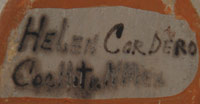 Everyone should know that Helen Cordero made the very first storyteller figurine in 1964. She created this first pottery figurine of an adult male with numerous children clinging to every part of him. This was the beginning of the "storyteller" figurine and was inspired by memories of her grandfather years earlier-a tribute to him-who was a storyteller at the pueblo.
Everyone should know that Helen Cordero made the very first storyteller figurine in 1964. She created this first pottery figurine of an adult male with numerous children clinging to every part of him. This was the beginning of the "storyteller" figurine and was inspired by memories of her grandfather years earlier-a tribute to him-who was a storyteller at the pueblo.
Since the figurine was in tribute to her grandfather, all of her storyteller figurines are male. She never made a female storyteller. Her female figurines are called other names, such as Singing Mother. Cordero used to say that the other potters who made female storyteller figurines didn't understand her intent. However, Alexander Girard, the great folk art collector, did understand this significance of her efforts and encouraged her to create more by purchasing all she made in the early days.
Helen Cordero, Cochiti Pueblo, who passed away on July 24, 1994, was truly an original artist. Unable to fashion pottery vessels in a manner with which she could be satisfied, she changed her course to figurative pottery, rather than give up altogether. Little did she know that she was starting a new tradition and changed the course in Pueblo pottery production. Now, all the Pueblos make storyteller figurines-not just Cochiti Pueblo. A storyteller made by her is to be a treasured item in any collection.
Title: Cochiti Pueblo Male Storyteller with a Child and Dog
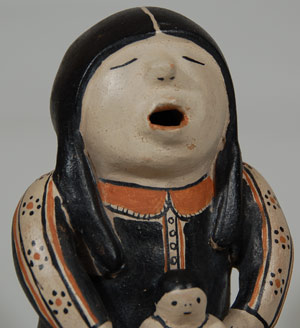 What is known today as a Storyteller figurine had its beginning in 1964 from the hands of Cochiti Pueblo potter Helen Cordero. Alexander Girard, the noted architect and folk art collector, saw a figurine by Cordero at a Santo Domingo feast day arts and crafts booth and requested that she make more and larger ones and bring them to him. He continued to encourage her to make larger ones with more children. When Cordero began thinking about his requests, she made a male storyteller with several children based on her remembering that her grandfather was a storyteller at the pueblo. Her creation, based on her grandfather, was the beginning of the storyteller figurine tradition at Cochiti Pueblo. In the almost five decades since her creation, the storyteller figurine tradition has blossomed.
What is known today as a Storyteller figurine had its beginning in 1964 from the hands of Cochiti Pueblo potter Helen Cordero. Alexander Girard, the noted architect and folk art collector, saw a figurine by Cordero at a Santo Domingo feast day arts and crafts booth and requested that she make more and larger ones and bring them to him. He continued to encourage her to make larger ones with more children. When Cordero began thinking about his requests, she made a male storyteller with several children based on her remembering that her grandfather was a storyteller at the pueblo. Her creation, based on her grandfather, was the beginning of the storyteller figurine tradition at Cochiti Pueblo. In the almost five decades since her creation, the storyteller figurine tradition has blossomed.
Today, many potters at almost all the pueblos make figurines, some male and some female, but Cordero continued only making male storytellers because of the connection to her grandfather. She never made a female storyteller. Her female figurines are called other names, such as Singing Mother, Hopi Maiden or other names. Cordero used to say that the potters who made female figurines and called them storytellers didn't understand her intent.
This figurine is a testament to Cordero's talent. It is beautifully sculpted and painted. The single child sitting in the adult's lap has his hands crossed over his chest as he stares down at his dog who is sitting on the leg of the adult. The adult's shirt is beautifully designed and decorated. His hair hangs down in braids over his shoulders. He wears the old traditional white cotton pants and cow hide moccasins.
Condition: original condition
Provenance: Adobe Gallery sold this figurine to the current owners in 1999 and they have now brought it back to us to sell for them.
Recommended Reading: The Pueblo Storyteller: Development of a Figurative Ceramic Tradition by Barbara Babcock.
Title: Cochiti Pueblo Male Storyteller with a Child and Dog
Artist / Potter: Helen Cordero (1915 - 1994)
Category: Figurines
Origin: Cochiti Pueblo
Medium: clay, pigment
Size: 7-1/2" tall x 4-1/2" wide x 6-3/4" deep
Item # C3352A
Title: Original Painting "Buffalo Hunt" by Quincy Tahoma
When this painting was completed in 1948, Quincy Tahoma was very active. His friends who had joined the military for World War II had returned home and Tahoma was in love with a young lady in Santa Fe. The overall activity in Santa Fe was bustling and sales were good for him. He was displaying his art at the studio of T. Harmon Parkhurst and residents were actively purchasing it.
The Museum of New Mexico Gallery had featured Tahoma's work in the summer of 1946 and also forwarded two of his paintings to Oklahoma for the first annual Philbrook Indian Art competition at which Tahoma won first prize in the Southwestern painting division of the competition. He had achieved the status as one of the best Indian painters in the land.
One of the subjects Tahoma loved painting was that of a buffalo hunt. He seemed to thrive on the active style of running buffalo. In this painting, there are four buffalo, or bison, in the foreground running away from the two Indians on horseback with drawn arrows in the background. The Indians and horses may appear small but their detail is extraordinary. The cartouche signature block shows a couple of the bison stumbling after being hit with arrows although there is no blood or kill in the actual painting.
For anyone interested in the life and art of Tahoma, I strongly recommend the recently-released book Quincy Tahoma: The Life and Legacy of a Navajo Artist by Havens and Badertscher
Condition: there is some discoloration of the paper at the very top of the painting. It is currently visible but could easily be concealed if re-matted. There is plenty of room to cover the discoloration with proper matting.
Provenance: from the collection of a resident from Santa Fe
Recommended Reading: Quincy Tahoma: The Life and Legacy of a Navajo Artist by Havens and Badertscher
Title: Original Painting "Buffalo Hunt" by Quincy Tahoma
Artist: Quincy Tahoma 1917-1956 Water Edge
Category: Paintings
Origin: Diné - Navajo Nation
Medium: Gouache
Size: 14" x 11" image; 21-1/2" x 17-1/2" framed
Item # C3178
Biography: Tony Da 1940-2008
Tony (Anthony Edward) Da descended from a most talented family of potters at San Ildefonso Pueblo. His father, Popovi Da, was one of the first pueblo potters to break with tradition and create something other than black-on-black pottery. Likewise, his grandparents, Maria and Julian Martinez, were even more ahead of their time when, in the early 1900s, they broke with tradition when they created the now-famous black-on-black pottery, breaking away at that time from the polychrome wares that were traditional. With such a talented family, Tony was destined to be talented and famous, and certainly he was.
Maria and Julian were the first to transform everyday utilitarian pottery into non-functional works-of-art pottery when they fully developed the black-on-black wares around 1925. Following his father's death in 1943, Popovi Da began assisting Maria, and by the 1950s he began infusing his own ideas into pottery making. Popovi began painting magnificent polychrome pieces reminiscent of his father's early works. Then he began to experiment with inlaying turquoise into pottery. It was this technique that Tony picked up on and eventually perfected.
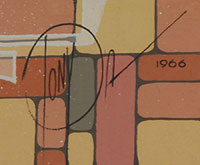 Tony was born in 1940 and in his early student years experimented in jewelry making and painting. Following a stint in the U.S. Navy, he returned to San Ildefonso in 1964, was fascinated with what Maria and Popovi were doing, and apprenticed himself to his grandmother.
Tony was born in 1940 and in his early student years experimented in jewelry making and painting. Following a stint in the U.S. Navy, he returned to San Ildefonso in 1964, was fascinated with what Maria and Popovi were doing, and apprenticed himself to his grandmother.
Tony drew easily but selectively on his experience with both painting and jewelry. Early on, he worked in the two-tone black-and-sienna style, which Popovi Da introduced. He moved rapidly into the setting of turquoise into some of his wares, such as lidded vessels, bear fetishes, and sculptures of turtles. Indeed, Tony was the first pueblo potter to make extensive use of turquoise inlay in pottery. He next produced magical combinations of clay and wrought silver, as well as pottery inlaid with shell beads (hieshe). Tony's work is immediately recognizable, and viewers have compared his more complex pieces to such objects as Middle Eastern jewelry boxes and Byzantine reliquaries.
"Tony soon excelled as one of the pace-setting pioneers in incising designs into pottery surfaces, combining delicately etched images with inlay and red, sienna, or two-tone finishes to create works with wholly novel effects. A favorite incised motif was the avanyu, the plumed water serpent associated in pueblo lore with summer rains. In other pieces he used a buffalo with heartline, or motifs inspired by the prehistoric Mimbres culture, including the feather motif popularized by his grandfather. As a measure of his rapid progress, in 1967, just three years after beginning his apprenticeship with Maria, Tony's works appeared with his grandmother's and father's in the definitive "Three-Generation Show," an exhibition honoring the pottery art of the Martinez-Da families at the U.S. Department of the Interior in Washington, D.C.
Ever since, Tony Da's inspired, innovative body of work has exerted an enormous impact on the look of pueblo ceramics. An artist of conspicuous ability and clear vision, he came upon an art scene very much in flux-thanks, in large part, to the efforts of his own family. Tony built something new upon the foundation provided by his predecessors. Tony was one of those rare figures who rise up from the artistic continuum, a gifted innovator whose work signaled significant changes in the mainstream of pueblo ceramics. When such contributions find favor, as his did right away, they work their way into the accepted vocabulary of the art form and within a generation come to be thought of as ‘traditional.'"
The Martinez-Da family was fraught with tragedy, especially on the male side. Julian Martinez died prematurely in 1943, at the age of 46 years. He was at the peak of his career. Popovi Da, likewise, died early, in 1971, at the youthful age of 48 years. Tony's career ended abruptly around 1980 (exact date undocumented), at the age of about 40 years, as the result of an off-road motorcycle accident that precluded his return to pottery making. With the wonderful artistic creation left to us by these remarkable men, one must wonder what they would have gone on to do had they been able to create for another ten or twenty years.
Reference: "Tony Da" by Ron McCoy, in Art of Clay, Timeless Pottery of the Southwest, edited by Lee M. Cohen. Clear Light Publishers, Santa Fe. 1993. Permission granted by Phil Cohen.
Famed San Ildefonso Pueblo potter and artist ANTHONY "TONY" EDWARD DA passed away peacefully on the 12th of February, 2008 at 67 years of age.


